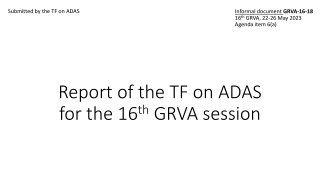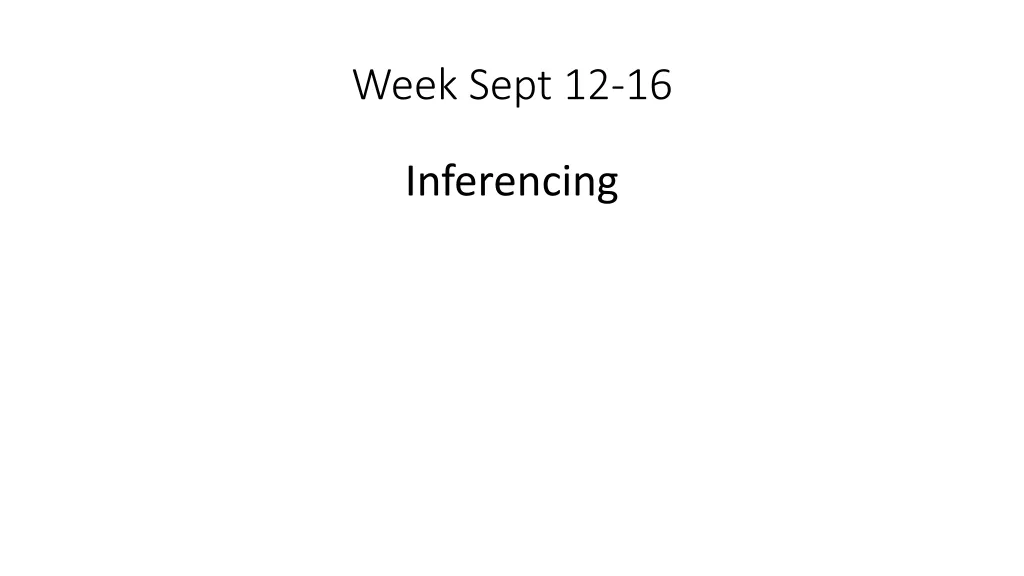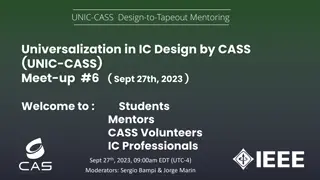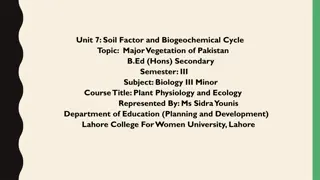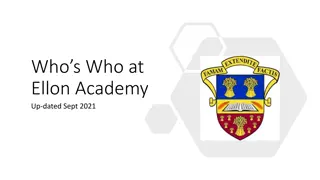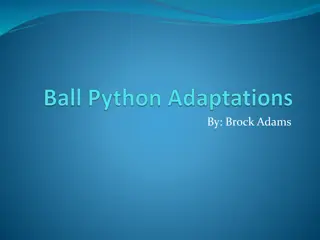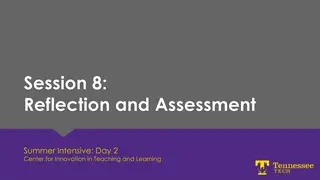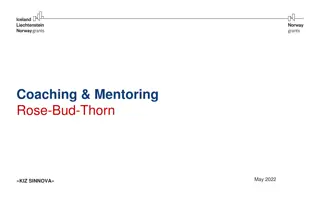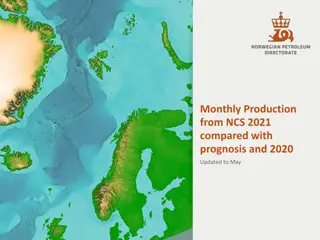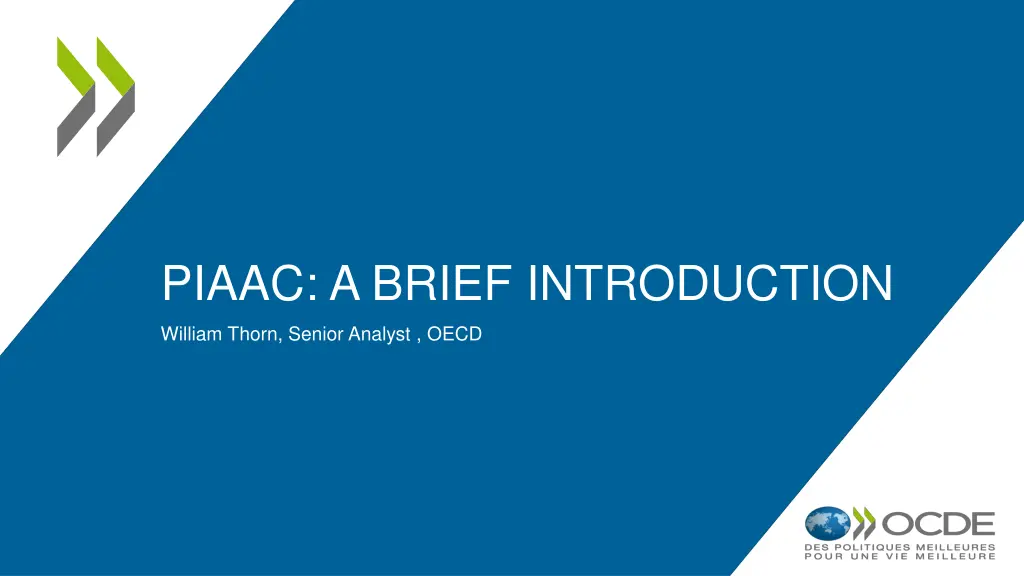
PIAAC Overview and Assessment Results
Explore the Programme for the International Assessment of Adult Competencies (PIAAC) which assesses literacy, numeracy, and problem-solving skills of adults aged 16-65 through household-based studies conducted across multiple countries. Learn about the skills assessed, background questionnaires, and international assessments of adult literacy, including data collection cycles and skills evaluated. Discover how PIAAC aims to enhance adult learning and skill development for a dynamic world.
Download Presentation

Please find below an Image/Link to download the presentation.
The content on the website is provided AS IS for your information and personal use only. It may not be sold, licensed, or shared on other websites without obtaining consent from the author. If you encounter any issues during the download, it is possible that the publisher has removed the file from their server.
You are allowed to download the files provided on this website for personal or commercial use, subject to the condition that they are used lawfully. All files are the property of their respective owners.
The content on the website is provided AS IS for your information and personal use only. It may not be sold, licensed, or shared on other websites without obtaining consent from the author.
E N D
Presentation Transcript
PIAAC: A BRIEF INTRODUCTION William Thorn, Senior Analyst , OECD
Purpose Briefly describe PIAAC, and present some results.
PIAAC: the basics PIAAC the Programme for the International Assessment of Adult competencies Household-based study that assesses literacy, numeracy and problem solving skills of adults Target population: 16-65 year olds 1stcycle of the study has involved three rounds of data collection 2011-12 (24 countries) 2014-15 (9 countries) 2017-18 (6 countries) 2ndCycle in preparation data collection in 2022-23
Skills Assessed accessing, using and reasoning critically with mathematical content, information and ideas represented in multiple ways in order to engage in and manage the mathematical demands of a range of situations in adult life. Literacy accessing, using and reasoning critically with mathematical content, information and ideas represented in multiple ways in order to engage in and manage the mathematical demands of a range of situations in adult life. Numeracy Adaptive Problem Solving the capacity to achieve one s goals in a dynamic situation, in which a method for solution is not immediately available. It requires engaging in cognitive and metacognitive processes to define the problem, search for information, and apply a solution in a variety of information environments and contexts 4
The background questionnaire Section Content Background Information Education and Training Labour Force status and work history Characteristics of current job Characteristics of last job (if unemployed and worked in last 5 years) A B C D E F Literacy, Numeracy and ICT Practices at Work Literacy, Numeracy and ICT Practices in Everyday Life Working Environment About Yourself (social trust, cultural capital, family situation when young , parental background) G H I J Personality traits (the Big 5)
International assessments of adult literacy Study Date(s) of data collection No. of Countries Skills assessed IALS 1994, 1996, 1998 21 Literacy ALL 2003, 2007/08 11 Literacy, Numeracy, Problem Solving PIAAC (Cycle 1) 2011-12, 2014, 2016 39 Literacy, Numeracy, Problem Solving in Technology-Rich Environments PIAAC (Cycle 2) 2022-23 33 Literacy, Numeracy, Adaptive Problem Solving Comparable measures over time: Literacy: from 1994 to 2022/23, Numeracy: from 2007 to 2022/23
Literacy proficiency of adults Literacy score 300 280 260 240 220 200 180 160 Northern Ireland United States Peru Hungary Denmark Australia Finland Chile Greece Austria Slovak Republic Russian Federation New Zealand Estonia Norway Ecuador Kazakhstan Singapore France Spain Czech Republic Ireland Korea Flanders (Belgium) Netherlands Mexico Israel Italy OECD average Slovenia Cyprus Germany Canada Sweden Turkey Lithuania Japan Poland United States 2017 England (UK)
Literacy and socio-demographic characteristics: a summary OECD average Differences in literacy score Gender Men - Women Parents education At least one parent attained tertiary - Neither parent attained upper secondary Educational Attainment Tertiary - Less than upper secondary (adults aged 25-65) Age 25-34 year-olds - 55-65 year-olds Immigrant background Native-born and native-language minus foreign-born and foreign-language 0 10 20 30 40 50 60 70 Score points
Skill proficiency and age: OECD OECD literacy OECD numeracy Score 300 290 280 270 260 250 240 230 220 210 200 15 20 25 30 35 40 45 50 55 60 65 Age
Numeracy and positive outcomes Percentage-point change associated with a change of one standard deviation in proficiency in numeracy (OECD average) 8 7 6 5 4 3 2 1 0 High levels of trust High levels of political efficacy Participation in volunteer activities High levels of health Wage
Research using PIAAC data Wide range of topics and themes explored relating to : Labour market participation and outcomes, skill match/mismatch, inequality, development of skills, transitions through education and into work, schooling, lifelong learning, health outcomes, skills development, immigrants, automation, adult learning, methodological questions .
Where to start Reports and other publications: https://www.oecd.org/skills/piaac/publications/ PIAAC Bibliography
Find Out More About PIAAC at: www.oecd.org/site/piaac All national and international publications Email william.thorn@oecd.org The complete micro-level database Thank you


